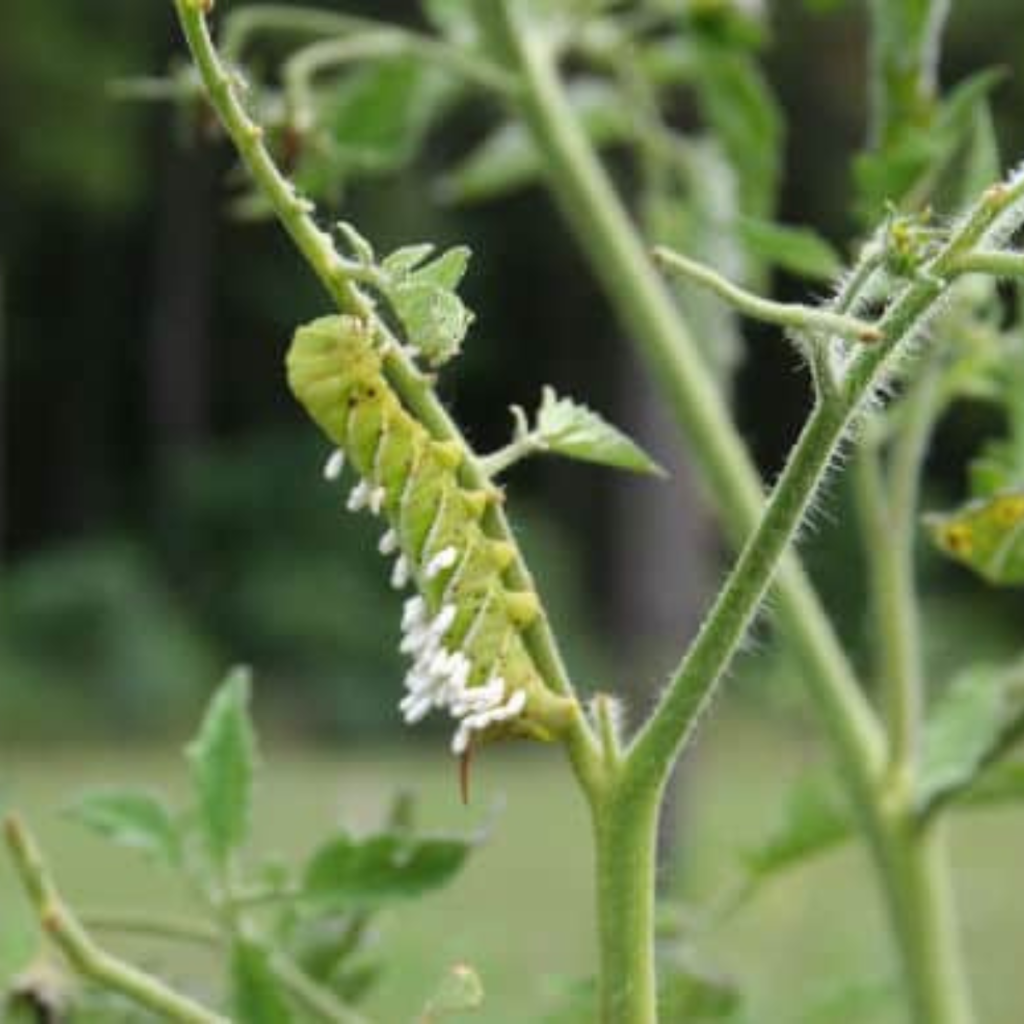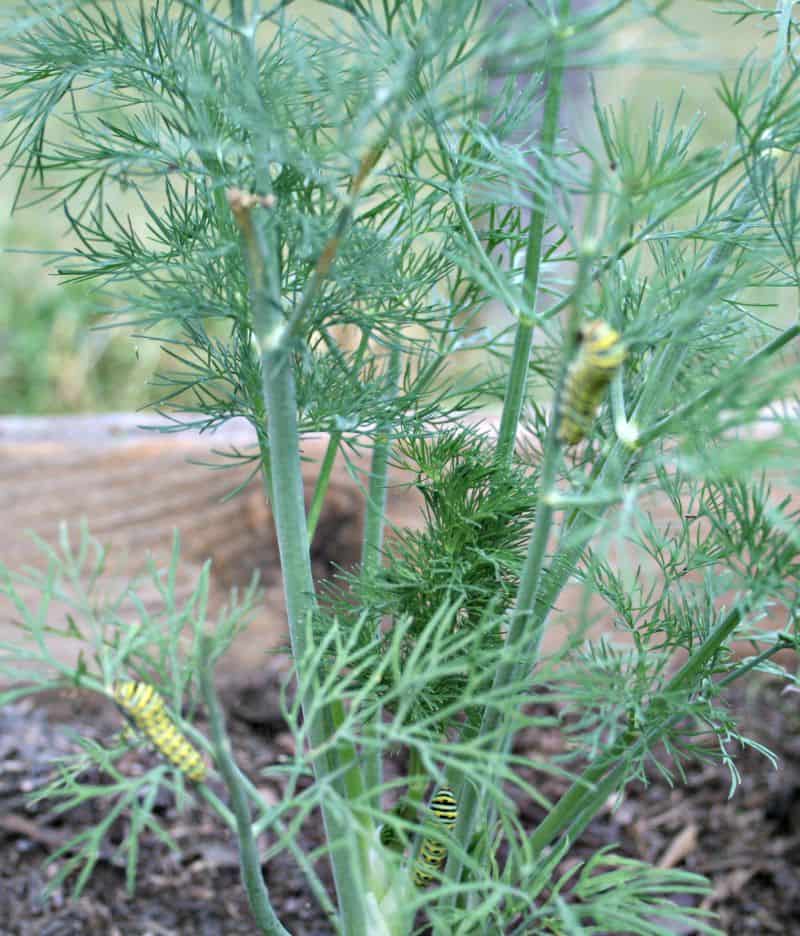As soon as you see them, your first thought is going to be, “How do I get rid of tomato hornworm?” These are ugly, damaging caterpillars, the larva of the five-spotted hawk moth. Here’s how to get rid of tomato hornworm – for good- this season.
Get Rid of Tomato Hornworm Using Organic Methods
How to get rid of tomato hornworm using organic methods takes time, patience…and a strong stomach! Tomato hornworms or tomato worms can easily decimate your entire tomato garden in one evening. They are ugly, big, scary-looking green worms about an inch long with two “horns” sticking out of their heads. Tomato worms have green horns while tobacco worms have red horns. Either way, they love to munch on the leaves of tomato plants and will strip all the leaves off of a plant in one evening. It’s like an alien invasion.
Many people want an immediate solution to their problem, and there is one, but it’s not particularly appealing. Go out into the garden. Wear thick gloves. Pick the worms off by hand (told you this wasn’t appealing), drop them in a bucket and squash them (even less appealing, right?).
Can You Find the Tomato Hornworm?
The problem, of course, is finding the nasty monsters. They’re green for a reason – nature makes them very difficult to spot. Their coloring mimics that of the tomato stems upon which they climb, perch and feed. It is also difficult to find them during the day. One year when I was growing tomatoes in big pots on my desk, I knew by the damage that I had a tomato hornworm of two lurking among the plants. But I couldn’t find them…until I went to lift the pot. There they were, hiding under the planter rim. They are crafty, those tomato hornworms.
So what can an organic gardener do to rid their tomato patch of those pesky tomato worms? Fortunately, organic tomato worm control starts with the garden. Plant companion plants to repel tomato hornworms and plants that attract its natural predators. While it takes time to use organic gardening methods, these and a few simple gardening techniques can greatly reduce an infestation and minimize damage.
Cultivation Practices Prevent Tomato Hornworm
Two simple practices can reduce the potential for tomato hornworm infestations: crop rotation and soil cultivation.
- Crop rotation: Crop rotation means that you do not plant the same crop, or a vegetable in the same plant family, in the same location from year to year. If you plant tomatoes in bed one in your garden this year, next year do not plant tomatoes or their near relatives in the plant kingdom in bed one. Plant something else, like lettuce or root crops. The reasoning behind crop rotation is simple. Insects that attack plants are likely to linger nearby. After all, they’ve found a potential food source. Tomato worms will lay their eggs in the soil near tomato plants. If you move your tomato plants to another bed each year, the worms may hatch, but they will not be able to obtain enough food to turn from caterpillars (the correct name for the worms) into moths.
- Soil cultivation: Another simple organic gardening practice that can reduce tomato hornworm infestations is cultivating the soil. Since the hummingbird or sphinx moth lays its eggs in the soil near the tomato plants, if you take a garden hoe and cultivate the soil, you are likely to disturb the insect’s eggs or pupae when they hatch. This also keeps them from growing up into tomato worms…and from eating your plants.
Companion Plants and Predatory Insects
Companion planting can be used for many reasons. Sometimes companion plants help vegetable plants grow stronger, bigger, or tastier vegetables. Others, such as marigolds, are planted near tomatoes to repel damaging insects. Marigolds are one of the best companion plants for tomatoes because the chemical that gives the flowers their distinctive scent also repels tomato hornworms. Plant a border of marigolds around your tomato plants for the best protection. It may not repel every tomato worm, but it will help.
Nature also provides several unique predators of tomato hornworms. One of them is the predatory wasp. These tiny wasps lay their eggs on the hornworms. When they hatch, they develop into pupae and cling to the worm. They actually eat the worm for food as they grow, and the worm dies. It’s disgusting, I know, but boy, does it work. The photograph accompanying this article shows a tomato hornworm in my garden last summer covered with predatory wasp eggs. If you see such hornworms, leave them alone – the wasps will take care of the tomato worm, and you will also encourage the wasps to reproduce.

To attract predatory wasps to the garden, it’s important to grow plants that they feed upon for nectar. One such plant is dill. Dill also feeds many other types of caterpillars. Other plants that attract predatory wasps are spearmint, tansy, and sweet alyssum.

Companion Planting: Keeps Hornworms Away!
Do you notice anything about the companion plants for tomatoes? Many herbs make fine companion plants. Our ancestors knew a thing or two when they grew kitchen or potager gardens. These gardens are a mixture of vegetables, fruits, herbs, and flowers. They form an attractive and edible landscape, and many were designed around the concept of companion plants. You may want to try growing marigolds and sweet alyssum near your vegetable plants to attract beneficial insects, repel harmful insects, and add beauty to the garden.

Organic Sprays for Tomato Worm Control
If all else fails, an organic spray called Bt (short for Bacillus thuringiensis) is a relatively safe organic pesticide. It works against potato beetles and tomato hornworms using biological, bacteria-based controls. If used according to the label directions, it should not harm beneficial insects such as lady beetles (ladybugs) or other beneficial insects you want to attract to the garden. But please use the same care and caution with Bt and other organic insecticides as you would with conventional ones. Just because something is marked “organic” doesn’t mean you should be careless with it in the garden.
For more information on controlling and ridding your garden of tomato hornworm, see:





[…] tomato hornworm strikes at night, chomping at the tender green leaves of your tomato plants. When you greet the […]